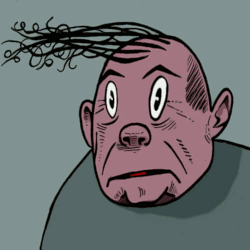
Index:
1) Intrusive Thinking and Creativity
2) The Role of Missing Information in Creativity
3) Art and Algorithms
4) Art, A.I., and Culture
5) Autism and The World
6) YouTube Channel and Miscellaneous

Intention and The Virtue of Not Knowing: Nineteenth Century authors who delved into the mysterious and supernatural often couched these themes in the prevailing rationalism and science of their time.
Guy de Maupassant’s short story, La Horla, chronicles a man’s descent in madness. In the middle of this tale, the protagonist travels to Paris to forget his troubles. There he meets with a mesmerist (hypnotist) whom he watches hypnotize a family member. This was Maupassant’s attempt to explain, or analogize, scientifically, what was happening to his character’s mind.
To modern readers, however, his intent may well be missed. In hearing this story, my first reaction to the introduction of this series of strange and seemingly unrelated scenes of mesmerism was one of surprise and delight. The author appeared to be anticipating, by a half century, avant-garde elements of storytelling. I was primed to accept this interpretation because I had used this very device in my second novel, where a mysterious hypnotist appears early in my book, although what role he plays in transpiring events is never explained.
Maupassant was known for his plot twists, and his sudden transition to mesmerism as subject matter was to upend his story entirely. This was not his intention, as it turns out. Still, this mystery within a mystery would have been what I most remembered about La Horla had I not heard the story explained.
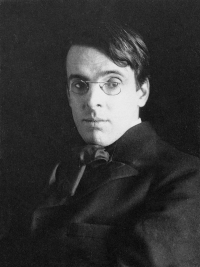 William Butler Yeats
William Butler Yeats
Poetry as Missing Information: Poetry is one area of creativity that I have explored little. I tried to write it early in my development as a writer, but I tackled it too early to do much good with it. However, as I have grown as an individual, I have come to appreciate the opportunities it provides for its geniuses, especially those who, in some sense, travel close to my interests.
ee cummings reassembled language in alien ways. Descriptive verbs and adverbs became nouns in their own right through his poetry, thereby creating a place where the verbal and nonverbal worlds slid over one another to mutual benefit. Nietzsche was not a poet, yet danced around poetry just enough to skirt the profound on every topic he touched.
My favorite poet is W. B. Yeats, whose occultism, far from being flakey, allowed him to visit the far side of human mortality and return with eyewitness reports. He described the world we live in with startlingly fresh eyes, as one who came to it from the other side of death.
Literary One-Off: The short story called Lazarus, by Russian writer Leonid Andreyev, is one of the most unsettling stories you will ever encounter. It is polar opposite to Yeats, but no less powerful. It is perhaps the greatest horror story ever written that has nothing to do with the supernatural. In fact, it is so unsympathetic in its existentialism that it might be compared to lying in a coffin for an hour, with only the wooden lid for company.
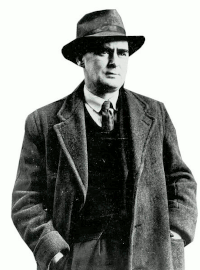 Flann O’Brien
Flann O’Brien
The Mistaken Premise: As an author, I would describes my life as being based on a false premise: namely, that I believed I was “normal” when, as my Asperger’s diagnosis later revealed, I was not. This masquerade is explained through analogy in my online novel Icarus Transfigured.
A major influence on my novel is a work of fiction I read in graduate school called The Third Policeman, written by the Irish writer, Flann O’Brien. Apart from naming my Irish tavern after his book, I borrow two ideas from him: one, a mysterious and recurring black box; and two, his story-within-a-story about a philosopher who is an object of study for the protagonist. In my novel, an unpublished memoir, penned by an eccentric architect, plants clues, including how the writings of Aiden and those of his friend Omar bare comparison to it.
My mistaken premise lacks the stock features of O’Brien’s since I make every effort to obscure it. The big reveal, which is first described loosely as the premise of an impossible television program by Omar, is less like a revelation and more like a Russian nesting doll: With its each iteration, it become more opaque to reason. Notably in the last chapter of Icarus Transfigured, we break with the novel’s informal division of scenes to navigate harder divisions, so one might imagine TV commercials being inserted into them. This pretense is kept up through to the closing Epilogue.
I recently discovered the novel House of Leaves by Mark Danielewski. It was written three years before my first draft of Icarus in 2000, yet possesses elements common with my novel. I cannot help but wonder if the writer also read The Third Policeman.
Bait-and-Switch Plots: Bait-and-Switch plots are rare, and perhaps because they require preparation. It is easier to add a switch-up to something that is already written, yet can be adapted. Sometimes this switch happens naturally in the course of writing, especially where one is making it up as one goes along. And not every bait-and-switch story is a straightforward proposition. Sometimes a shift in tone or emphasis marks the transition.
Gerald Durrell’s short story The Entrance is light on plot, but not design. It begins like a gothic romantic novel, with richly layered descriptions of food, wine, and a provincial French manor. One can somewhat anticipate the type of story it will become, but the exposition is so seductive that when the twist arrives, it is both grotesque and unexpected. We pass from throwing chestnut roots on the hearth fire to confronting a flesh-eating goblin (who dwells in a full-length mirror). The unlikely monster creeps up on us like another bottle of merlot we are about to uncork.
The Entrance’s ending is hurried, and less satisfying that the story overall. This criticism can be made of short stories, generally. Forty minutes is the average reading time of a well-crafted short story. The Entrance doubles this, yet it cannot escape the shortcomings of the short story format: Fewer pages equals less emotional investment in the characters and storyline by the reader. Where there is so little ground to cultivate, the writer may choose to concentrate on one aspect of his story, while allowing other parts to be filled in by bullet-point template. It is a trade off, but a writer may reinvent this straightjacket as his imagination allows.
Metaphysics and Strange Fiction: H. P. Lovecraft and his circle are among the first writers to explore the idea of metaphysical horror, or at least to package it in modern terms. In this fiction, a physical or elemental force cannot be understood through either the senses or as an intellectual idea. Lovecraft was gifted at describing monsters and states of madness associated with being in their presence, although he was not so good at other things like plot, character development, etc. Metaphysical horror these days is more properly described as strange fiction, where the elemental force straddles a line between a Lovecraftian dimension and our physical world. These post-modern writers are generally better than Lovecraft at withholding information from the reader in order to underscore the unnerving aspects of being left in dark rooms.
I have written two novels that may be characterized as works of strange, speculative, or metaphysical fiction.
The Allure of Strange Fiction: A plot may begin conventionally. Once the intrusive idea is introduced, the story, from the point of the insertion back to the story’s beginning, takes on a coloring. One might even call it a contamination. My reaction to a novel development in a story is to re-experience the story in its entirety—and sometimes repeatedly. This may be compared to visiting a tragic location of some legend, and examining cobblestones in the vicinity that, by inference, recorded the event.
The intrusion should never be explained, even if clues are surreptitiously planted. The goal is to leave the reader feeling like a collaborator, in that he or she must supply more information than was factually communicated by the author.
 Guy Fawkes Night
Guy Fawkes Night
“A Penny for The Old Guy”: Here is an interesting example from strange fiction writer, John Metcalfe, and his story The Funeral March for a Marionette, which I heard through Jasper L’Estrange’s wonderful YouTube channel Encrypted.
I was familiar with Guy Fawkes Night, as well as early photographs of British children using pauper effigies while panhandling on the streets of London. I did not realize that the two things were connected until I came across this story—and only after re-listening to it and, some weeks later, running across certain creepy photographs in my digital image collection.
Metcalfe’s story is meant to be ambiguous, although we soon suspect that the two panhandling boys in his tale are not wheeling around a simple stuffed effigy in their wheelbarrow. Things go awry in the course of their adventure, yet we never discover just who or what is in the company of the children. The unsettledness of this entity is similar to the monstrous baby that serves as the unexplained centerpiece to David Lynch’s movie Eraserhead, although, in Metcalfe’s example, his centerpiece is only ever described in guarded language, and then never completely. What we are given are reactions to this silent companion from passersby, who are unhinged to the point of leaving the immediate vicinity.
As someone with an impaired ability to follow complicated stories, mysterious stories may be more mysterious than the author intended. Still, even with subsequent explanation being provided by Metcalfe, The Funeral March for a Marionette remains frightening, but perhaps not as frightening as when I possessed less information about it.
Autism and The Genius of Missing Information: It is perhaps due to my autism that I have trouble following stories so well as is to be desired. I cannot keep straight the names of characters, or their relations, and sometimes lose track of important explanatory information. This lack of information can make stories seem more inscrutable, and therefore more interesting, although this judgment arises from a subjective experience. Still, it is the rare creative writer or film director who feels comfortable with deliberate ambiguity.
Could this autistic blindspot account for a certain type of creative individual? I am thinking again of David Lynch, who steps in an out of rationality as one who feels unusually easy with missing information. Of course, you must pick your battles, and resist the temptation of over-indulgence in leaving too much unexplained material lying about.
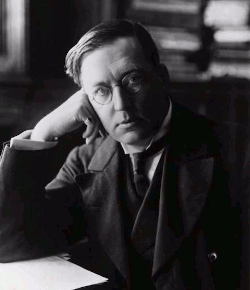 Montague Rhodes James
Montague Rhodes James
M. R. James and Strange Fiction: Before Lovecraft, there were a number of Edwardian writers who explored metaphysical dimensions of the supernatural. I am choosing to highlight two lesser known tales by M. R. James for their intrusive aspects.
James’ “ghost stories” are seldom populated by ghosts. Like Welsh writer Arthur Machen, he anticipates the folk horror literary genre, where the dark English countryside conspires against those who do not know better than to leave things buried in the ground: Spades in dirt… rediscovering lost rites… reciting ritual words carved on ancient stones… Such secret knowledge is bound to evoke elemental forces hitherto lost with the pagans and early Christians.
While Machen focused on sinister “fairy folk,” James concentrated on entities that are harder to categorize. What sets James apart is not only his antiquarian background and storytelling abilities, but how other interests of his, not horror related, are roped into his yarns.
Few of his admirers talk about his sense of humor, which shows his love for both Charles Dickens and P.G. Wodehouse, especially in his comic portrayals of peripheral characters. They often appear out of step with the décor one finds typically in haunted houses. Modern critics see Edwardian elitism in these portrayals of domestics, but moral didacticism of this sort is the preoccupation of critics and not creatives.
More to the point, James’ sense of humor allows the horror element in his stories, which comes on the reader unexpectedly, to feel even more intrusive than it would be if one anticipated the drama from start to finish, such as in the natural course of a ghost story.
The Rose Garden: The Rose Garden is a short comical story about a hen-pecked husband and his overbearing wife. The subject of the story involves laying out a garden on their property, and the misadventure that follows. Near the end of the story, the wife, who is painting a watercolor in her new garden, sees a horrid pink face pop out from an unassuming hedge. It is then reaborbed back into the hedge like a nightmare.
Often the twist in a James’ story comes down to one or two artful sentences. The Rose Garden might otherwise be an episode of a British comedy show where, let us say, by way of example, a bat gets into the house. In chasing it about with a broom, the homeowners find that it is not a bat, or even a bird. Such was the genius of M. R. James.
The Diary of Mr Poynter is a similar comic story involving a domestic dust-up over a wallpaper design; it ends in much the same way.
After Dark in the Playing Fields: After Dark in the Playing Fields is an even stranger story, for it not only incorporates comedy but also the sort of fantasy one might find in the works of Lewis Carroll, Beatrice Potter, or other children’s book authors.
We begin with someone stumbling over a disgruntled talking owl. Having bought into this premise, the reader follows the story along in the way of a typical talking bird story, nearly through to its end. There, in the last paragraphs, James pulls the rug out from under his reader, after the owl has disappeared back into the dark foreboding English countryside—
You are brought face to face with the idea of just how disturbing a talking owl is.
I am sure James regarded After Dark in the Playing Fields as a minor work, and perhaps the introduction of horror at the very end was an afterthought. The story was unpublished in his life. And yet, even within his drafts of unfinished stories, he is able to intrude on our imaginations. The title: The Game of Bear alone conjures lines of Jamesian parlor room horror that practically write themselves.
(I have a fondness for unfinished works of music by classical composers, and see these glimpses behind the curtain as other unintended forms of intrusion.)
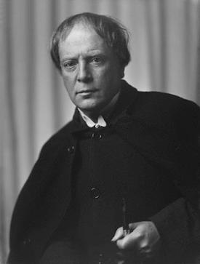 Arthur Machen
Arthur Machen
The White People: Arthur Machen’s stories have a different flavor than James’ parlor room plays. They have less humor and more literary exposition. The characters are not hapless, as with James, yet slide into their perdicaments with uneasy self awareness. One comes to understand the actions and intrigues indirectly, and often a cautionary moral dimension to the story is added at the end, which is more prescriptive than James’ approach.
One such story is The White People, which begins as a dissertation on sin between two gentleman over refreshments in a parlor room setting. A memoir is lent to one man by the other, and the story he reads follows a woman retelling her experiences with supernatural forces dating from childhood. This woman comes at fairy folk as through hallucinogenic experiences, yet we gradually discover that she has been introduced to these elementals by her nursemaid. The way the story unfolds is in how an innocent is seduced by a cult; and this makes the fairytales told to the child by her nurse all the more terrifying.
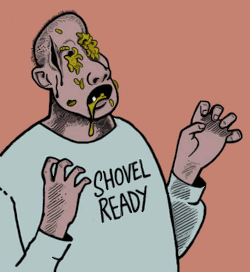
Taboos, Totems, and Politically Incorrect Symbology: Taboos work exceedingly well as intrusive ideas, if one is brave enough to use them. I know from my own output as an artist that they have been costly.
David Lynch has been criticized for the sexual violence in his breakout film Blue Velvet, although the violence is mostly left to the imagination of the viewer; and perhaps his critics have too much imagination. If one removes the suggestive power of violence from Blue Velvet, then the dichotomy between its dark and light elements is lost. The movie loses its tension and transcendence.
A Defense of Dali’s Eccentricity: I recently tried to watch a video by a YouTube creator who labelled Salvador Dali as a fascist because of 1) his ambivalence towards accursed political groups; and 2) his attraction to accursed political groups’ symbology as a visual language. A third reason lies in his support of Franco during the Spanish Civil War.
First, Dali had Aspergers—I am certain. His attraction to putting cameos of Hitler in his morally ambiguous paintings synchs with his descriptions of the role of symbology in art. Many people privately admired Hitler prior to his invasion of Poland, including playwright G. B. Shaw, the most famous socialist of his day. Dali was not unusual in this. To accuse Dali of being a Nazi sympathizer is like accusing pop surrealist Mark Ryden of being a closet republican because he puts so many Abraham Lincolns in his paintings. Ryden is a pop maven and symbolist, but Dali was the first to flaunt it, even before Andy Warhol. Moreover, Dali dropped images of Lenin into his paintings, also. Do these depictions spare him the vitriol of secondhand slander by moralizing leftists?
Moralism, as a litmus test for good art, is about useless as the intellectual claptrap modernists parade in public to defend third-rate talent. Such artists are copyists and confidence tricksters. Word salads only impressed weak minds and high brow revolutionaries. Geniuses of the calibre of a Dali or a Einstein are visual thinkers.
This same YouTuber praises Picasso’s Guerica as a call of arms against fascism, without addressing the fact that there were atrocities committed on both sides of the Spanish Civil War—by fascists, communists, and republicans alike. It was a war that divided a country, even to today. Franco is depicted as a villain in Western media, but he still has his supporters in Spain, so make of that what you will.
Dali was an oppositional thinker. Adopting a different political side than other artists requires intellectual energy to defend your views, especially since the views embraced by most artists, though morally proper for that crowd, are still a lazier kind of thinking: Everyone already agrees with you. More to the point, it is doubtful Dali ranked any of his colorful opinions, even where he contradicted himself on principle.
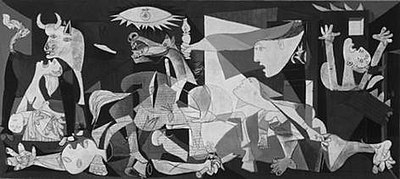 Guernica by Pablo Picasso
Guernica by Pablo Picasso
As a call to arms, Guerica was rather esoteric. I doubt many who suffered in Guerica could identify their suffering in Picasso’s abstract-figurative painting. The YouTuber points out how Dali’s admiration of Picasso was a one-way street, as if Dali deserved no respect from the greater artist. History has been less than kind to this view. Picasso fades into a backdrop of Modernist stylists while Dali continues to be a rock star.
Picasso is like Charlie Chaplin. His reputation as the exemplary genius of his age is the relic of a bygone mindset, where this mindset was informed by what immediately preceded it as culture. In losing this context, we are left with only the art to consider. Laurel and Hardy have dated better than Chaplin; and Dali was a better painterly craftsmen and imagineer than Picasso.
Interestingly, Robert Hughes, the most famous art critic of his day, regarded Dali’s graphic Soft Construction with Boilers Beans [A Premonition of Civil War] as being the greatest antiwar painting ever painted—not Guerica.
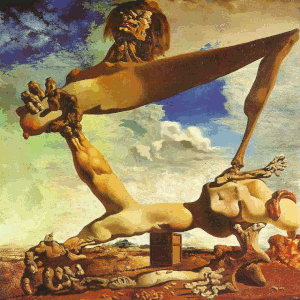 Soft Construction with Boilers Beans (A Premonition of Civil War) by Salvador Dali
Soft Construction with Boilers Beans (A Premonition of Civil War) by Salvador Dali
It is telling that this YouTube creator highlights how fellow surrealists, who prided themselves on being communists, tried Dali for his thought crimes and Hitler fixation. A show trial is such a Stalinist thing to do, so it seems fitting that both the surrealists and the YouTube creator should set store by it. If one is looking for fascists to put on trial in absentia, then the Italian Futurists much admired Mussolini in the early going of that dictator’s career. It is no surprise that surrealism went the way of Stalinism after the war. People had had their fill of strident opinions.
Dali eventually parted company with the surrealists; and yet… why did he suffer their intolerance for as long as he did? I suspect autism played a role here, too.
Luis Buñuel, who collaborated with Dali on the surrealist film, Un Chien Andalou, told the story how Dali was incapable of managing bus stops, and once required his assistance to catch a bus. Dali was probably frightened and confused by unknown situations. He likely saw his fellow surrealists as a family, and feared facing the world without the security they provided through their camaraderie. (He need not had worried.)
I am reminded of what Gala said about the surrealists. She slept through most of them, and stuck with Dali because, “he was the one with all the talent.”
Homunculus as Muse: I recently heard Edward Lucas White’s short story, Lukundoo, which is about an African explorer who, in being cursed by a witch doctor, lives to see his skin erupt with sores that sprout little full-grown Pygmy men (homunculus). We do not learn of his precise affliction until late in the story, and the scene set for the reader, in coming to these ghastly facts, is as horrific as it is surreal. The last Pygmy prophesies through words of cryptic poety, which is what elevates this story from the strange to the profound.
Lukundoo thrilled me, for not only was it original and akin to my artistic sensibility of building monsters out of unlikely things, but the story’s subject matter was daring—though perhaps more daring now than when it was first written a century ago.
Love/Hate Relationship with The Avant-Garde: I love the idea of the avant-garde, but it works better on paper than it does in practice. The difficulty that this type of idiosyncratic experimentation presents within cinema is easily appreciated. A film director can only make so many films, or, like Charlie Chaplin or Stanley Kubrick, re-shoot a scene so many times before budget restraints intervene. One need only look at David Lynch’s uneven output as a film director to see this. Perhaps it is because of this lethality that I keep my novels away from public daylight for as long as possible, so to rerun their sequences of absurdities again and again in my head to see if they produce my desired effect.
Unintended Juxtapositions: Rarely I happen upon an unusual video on YouTube that, in itself, involves a topic which is more interesting in theory than in execution. (This is like the problem with the avant-garde discussed previously.) However, because of the use of a ominous soundtrack, the material is elevated from the marginally curious to the downright disquieting.
YouTuber The Shourded Hand has done something like this with his video on The Bindendum Entity: Paranormal sightings of The Michelin Man are coupled with a sound score that plays a grouping of Bartok-like chords repeatedly throughout the presentation. The effect may be compared to Morton Feldman’s Piano and String Quartet which, at eighty minutes in length, plays the same disjointed, mournful fragment repeatedly with small variations. Should one add this music to an instructional hygiene film from the 1950s, it would produce the same haunted effect.
The Virtue of Mis-remembering: The monster movies that populated my youth dated from the 1950s and early 60s. These films were largely in black and white, and varied in quality, particularly where the featured boogeyman was concerned. Skillful cinematography could conceal much that was unconvincing in a fake rubber monster costume, and perhaps it is because childhood used to be simpler that one’s imagination inflated the scare factor in these films. The monsters from this era seem laughable by today’s CGI standards, or at least this is a superficial judgment.
One may compare these proto-monsters in form to how Japanese horror films, such as The Ring and The Grudge, transformed the mechanics of Kabuki theater into something modern and menacing: A tribal mask is potent precisely because of its Jungian wiring.
I remember, with terror, a monster movie from my childhood that is hard to describe. I recall only two scenes from it: The creature invades a woman’s house at night, and at first we see its hand creeping around a window curtain. When the woman opens a bedroom door to a dark hallway, she confronts the monster and screams. I can do no justice in describing this creature, or explain my abject fear to it no better. It kind of looked like a tall man wearing a turtle-like costume in shadow. This sounds silly, of course, but I have never found this old movie in all these years, even on YouTube. Perhaps I mis-remember the details, or have spliced together two different films. In which case, it is better left whole in my formative imagination, where it continues to inspire me.
 circa 2018 at the age of 60.
circa 2018 at the age of 60.
Deleted Scene From Novel-in-Progress: My new novel may be interpreted variously throughout the book. Scenes involving dialog are opportunies to write on subjects of interest to me. Many of these topics end up being scrapped for the sake of brevity. Here is one removed conversation topic that merits reading:
“Are you familiar with Henry Darger, the eccentric janitor who was a writer and artist? He invented a private world through his creative efforts that he never shared, or had desire to share. He is credited with writing the world’s longest novel, which was only discovered upon his death. I mention him because he was happily friendless, yet was a devout Catholic who attended Mass unfailingly. Though Christianity is thematically central in his book, he touches on it peripherally, and with what one can only presume to be the same pro forma regard he took weekly to Mass.
His book may be seen as a classic autistic creation, being essentially a playful (though tedious) catalog of lists of battles, place names, and proper names. I compare it to H. P. Lovecraft’s colossal ‘In The Mountain of Madness’, which, plotless, and virtually characterless, is little more than a run-on descriptive paragraph of interminable length. By the handwriting alone, one sees Lovecraft’s fugue state imagination rhapsodizing over peculiar predilections, and with little thought to their pertinence or repetition. He even relates the same joke twice, and to what effect other than he failed to catch it in proofreading—if proofreading was attempted.
In his constellation, his imagination led him into atheism, yet one might view his elaborate Cthulhu Mythos—his list-building, assigning proper names, etcetera—as rushing to fill a void where the soul, by its hierarchy-seeking nature, invents what it cannot discover through divine revelation. It is—again—a rejection of wholesale randomness. We will reject the world in its entirety before we reject our universes of abstraction.”
Liam reflected, “Darger’s obsession with hermaphrodite children would be viewed as disturbed, and most mainline Christians would similarly judge his individualized reconstruction of Christianity (much in the spirit of a William Blake), as being less a matter of creative adaptation of faith than one of inspired sacrilege.”
Copyright © 2022 michael l. teague all rights reserved.